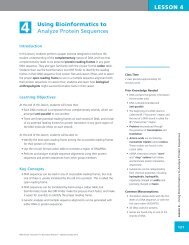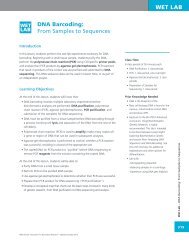LESSON 1: - Northwest Association for Biomedical Research
LESSON 1: - Northwest Association for Biomedical Research
LESSON 1: - Northwest Association for Biomedical Research
You also want an ePaper? Increase the reach of your titles
YUMPU automatically turns print PDFs into web optimized ePapers that Google loves.
STUDENT HANDOUT 1.4The Belmont ReportName____________________________________________________________ Date_______________ Period_______________The Belmont Report—Guidelines <strong>for</strong> Using Human Subjects in <strong>Research</strong>The Belmont Report was created in 1978 by the U.S. Department of Health to establish some basic ethical principles to beconsidered when people participate in research.1. Respect <strong>for</strong> Persons• Description: Respect <strong>for</strong> individuals and their autonomy; obtain in<strong>for</strong>med consent.• How is this applied?o A person has the right to make choices, hold views, and take actions according to his own beliefs.o If a person does not have the capacity to make her own choice, she must be protected from harm.o A person must enter into research voluntarily and must be in<strong>for</strong>med in an adequate manner.o To truly respect a person’s autonomy, he must be able to give genuinely in<strong>for</strong>med consent with full knowledge of bothharms and benefits of the study.On the back of this paper, give an example of how this principle was upheld or not from one of the case studies.2. Beneficence (or maximize benefits/minimize harms)• Description: Beneficence stresses “doing good” and “doing no harm” by minimizing all potential harm(s) and maximizingall potential benefit(s) to the subject as well as potential benefit(s) to society.• How is this applied?o There is an obligation to minimize the harm/risks to the greatest extent possible.o Maximize the potential benefits.o Ensure the rights and well-being of the patient take precedence over the needs of science.On the back of this paper, give an example of how this principle was upheld or not from one of the case studies.3. Justice• Description: Be fair in the distribution of the benefits and in bearing the burden of research.• How is this applied?o The benefits and burdens of the research should be justly distributed.o Guard against using vulnerable populations.o Ensure fair selection of research participants.o Guard against coercion and undue influence.o Avoid potential financial or other conflicts of interest.On the back of this paper, give an example of how this principle was upheld or not from one of the case studies.HANDOUTAutonomy: A person’s freedom and ability to make his or her own decisions.Coercion: The act of pressuring someone to do something using <strong>for</strong>ce, intimidation, or threats without respect <strong>for</strong> individualchoice. This includes the idea that a person with few choices may find participation in a study to be so appealing that theyfeel they cannot decline, even if being in the study is not a good decision <strong>for</strong> other reasons.Conflict of interest: A situation in which someone is responsible <strong>for</strong> making a decision in an official capacity(e.g., someone holding public office) that could benefit them personally.Undue influence: Is exerted when a person of higher power or authority takes advantage of another person; undueinfluence can often include coercion.Vulnerable (populations): Groups who may be exploited <strong>for</strong> use in research, e.g., children, people who are illiterate, and prisoners.© <strong>Northwest</strong> <strong>Association</strong> <strong>for</strong> <strong>Biomedical</strong> <strong>Research</strong>HUMANS IN RESEARCH |29
















